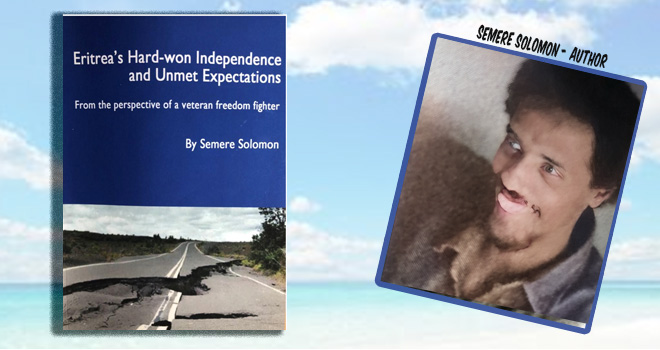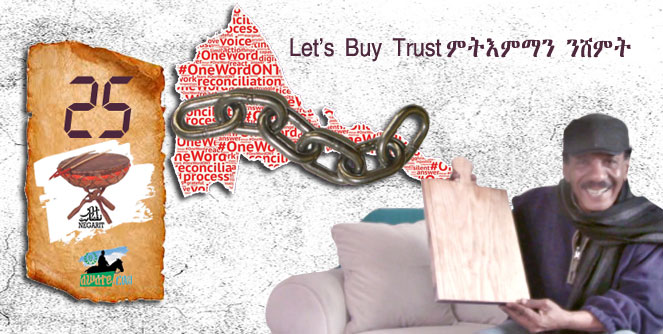Revelations of a Former Eritrean Freedom Fighter

To learn how a nation can spiral into a self-destructive vortex of paranoia, one should read Semere Solomon’s new book “Eritrea’s Hard-won Independence and Unmet Expectations,” which presents factual accounts based on his personal experiences in the battlefields of Eritrea as well as post-independence Eritrea.
This informative account is an attestation to readers not only the author is an excellent writer but also a deep thinker. He is a first-hand witness to juxtapose the essence of the armed struggle and what ensued after the costly revolution. In other words, the book is a testimonial to his fallen comrades; and a stern rebuke to the leadership that killed the Eritrean dream.
In his book, Semere has eloquently articulated the core causes that turned Eritrea up-side-down. His assessments and arguments are exceedingly credible and ingeniously coherent due to the fact that he himself lived through, as it were, the tough times as Eritrea’s dreams morphed into nightmares.
This is the kind of book that needs to be translated into local languages to provide Eritrean readers not only with an insight on how and why Eritrea failed to realise its potential, but also to offer them food for thought – with a wider range of ideas, knowledge, and perspectives for the much needed reforms.
Furthermore, the book is an honest and impassioned account of what went wrong in Eritrea, and what can be done to resuscitate it.
For the record, Semere is an ex-freedom fighter who sacrificed his youth to liberate Eritrea by actively taking part in the struggle for independence and served seven years in post-independence Eritrea as a civil servant.
Eritrea’s present-day hollow existence was not in the script, as far as the author is concerned. The costly struggle was meant to usher in a peaceful, prosperous, and democratic Eritrea. On the contrary, as Semere’s research took stock of the country’s current standing, Eritrea turned into a secretive, paranoid and imperious state.
Semere spells out that as far as he is concerned the buck stops with President Isaias Afwerki for all the deprivations took place on his watch. Moreover, the Isaias factor, as the author puts it, which can be characterised by his ruthlessness and brute force, gave rise to the prevalent atmosphere of subservience.
What is more, he argues, the country has become a spitting image of its leader, the condescending and aloof ruler who surreptitiously took the helm and ruled it with a heavy hand since independence – i.e. for over thirty years. Traits such as secrecy, paranoid nationalism, tactlessness, malice, presumptuousness, and more can be cited as some of his personal features that are projected on his administration, which eventually turned into a den of inequities. Simply put, the author sums up how the outcome of that unruliness is exhibited in Eritrea’s subsequent seclusion.
Additionally, the author explains that not only did the international community shun Eritrea for its human rights abuses; the diaspora has also stayed away from it due to various misgivings. For example, public participation was very high during the liberation struggle. As a matter of fact, many analysts assert the fact without the significant contributions of the Eritrean diaspora, independence would have never been realised. But unfortunately, after independence, the masses were considerably thwarted by the administration, as if they did not have the right to take part in the political processes that determined the country’s future.
One can argue that the international community noticed how Eritreans were short-changed by their own government; and this prejudice, the author stated, ended up isolating the state. Ultimately, Eritrea was given a rare designation used on unique states such as North Korea – it became known as ‘the North Korea of Africa’.
Fairly enough, Semere highlighted the factors that contributed to the country’s independence by giving credit to martyred comrades, and by keeping their individual histories alive. Not only did he recount that independence was the direct outcome of their sacrifices, but he also showed how their sacrifices were eventually betrayed by the current regime that continually exploited martyrdom to its advantage.
The fast-paced narratives are captivating. Semere’s approaches cover all aspects of the Eritrean ways of life – from the perspectives of veteran combatants, civil servants, the diaspora, the opposition, the dumbfounded domestic constituents, the international communities, regional countries and aid agencies.
His accounts expose the regime’s declarations, reports, bearings, and ‘achievements’ are nothing but a set of remarkable display of smoke and mirrors. To put it differently – as the title of the book indicates, ‘Eritrea’s hard-won independence’ ushered in ‘unmet expectations’.
The book is divided into two big sections. The first part is about the author’s reflections, personal experiences, assembled concepts, in-depth evaluations of Eritrea’s policies, the origins of the armed struggle and various accounts concerning the EPLF/PFDJ’s culpabilities. The best part of the first section concerns the author’s depiction of Eritrea’s standings from the point of view of various international institutions. Basically, he showed that Eritrea is lagging behind the rest of Africa on many issues.
The second part of the book consists of a collection of campaign articles the author wrote under the assumed name of Zaineb Ali. That alone demonstrates the author did not only take part in the armed struggle, served Eritrea as a civilian, but later decided to distance himself from the regime and started a new life after he found out the negative moral and political trajectories the country took after liberation.
The author did not quietly fade into obscurity after he left Eritrea for good. Many former combatants left the government of Isaias Afwerki in disgust and sank into obscurity. But it is fascinating to read how Semere, after he left Eritrea, rose from the ashes of the struggle with renewed energy to reconstruct his beleaguered life.
In his second life’ he campaigned hard to highlight the blunders of the regime of Isaias Afwerki. He was not confined to campaigning for the rights of Eritreans; he, as the back-cover blurb states, ‘pursued further advanced degrees and embarked on a career in global development, amassing over twenty-five years of rich experience. His professional footprint spans across diverse regions, including Africa, the Middle East, Asia and Central Asia’.
On top of leading a successful career abroad, he and his beloved wife managed to raise a family of three.
A Summary of the Book
The 440-page book has 17 chapters, two sets of photographs, numerous appendices, and a long conclusion that comprises some theoretical assumptions and facts.
The first few chapters provide a set of reflections on how Eritrea’s independence came about and the hopes and expectations it brought with it.
It was followed by a summary of the leadership’s degeneracies; and how things went down a slippery slope soon after the president started, rather recklessly, to vie for ‘the Gold Medal’ – to preserve himself as the sole bigwig in the country. The narrative is buttressed by how ‘a parade of horribles’ took place that led the country to its current state of affairs.
Moreover, the initial chapters provide accounts from domestic and international perspectives on how the country’s wayward direction has come to pass; and more, how the government neglected its domestic and diaspora affairs, triggering a mass exodus of its youth not only to neighbouring countries but far beyond its neighbourhood.
One can say it is an account that describes mistakes that were committed during the armed struggle, the Spartan lifestyle (a fiercely regimented one) that was introduced to suit the leadership after the struggle was over, the self-centred and exclusionist policies the regime put in place through PFDJ’s efforts, how an austere life dawned in liberated Eritrea, the unpalatable state of affairs that are prevalent in the country now, the various mini-rebellions that arose since independence, how the regime trounced on ‘deviant’ reform seeking citizens, and, by all means, the inevitability of change that awaits around the corner.
Semere also delves into how Ethiopia came back into the picture after decades of armed struggle, numerous conflicts, and tedious campaigns that took citizens in dizzying circles and then was suddenly ‘added’ (through the process of Abiy’s መደመር) to the list of friends… as if the histories of both countries do not matter.
Furthermore, he looked into the current condition of the opposition camp and the petty discords that divide them; and then went on to depict the nature of the impassioned youth, identified as the Blue Wave, as intrepid, and their daring efforts as gutsy.
Towards the end of the book, what stands out is Semere’s positivity regarding what is in store for Eritrea. One can say the author is an optimist who does not simply disregard the obstacles that are blocking change, but contending to crush them for the sake of the country’s promising future.
Reviewer’s Reflections
I sat down for a long time after reading the chapters in quick succession. The various episodes I read about in the book reverberated around me. I thought about a particular photograph I saw in the book – a martyred schoolmate of mine who stood tall among us when we were young boys.
He is gone, I am still here; and Eritrea is limping off the field. All I could think of was how life is not only strange but also unfair.
Ex-combatants usually use the ‘we’ pronoun rather than the first person singular in their writings. Semere’s usage of the pronouns is straight forward. He took ownership of his accounts by using the ‘I’ pronoun throughout the book. While he deserves praise for that endeavour, he, like the others, was frugal in some aspects of his personal accounts.
As a reader, I want to learn more about the writer’s personal accounts … how did he pass his days in the battlefield? How were his personal relationships with the local people, his comrades, his gun, the enemy, and others? What were his inner thoughts—his bitterness, wishes, dreams, and more? What were the battles in which he took part like? Death of a mate? What about the death of a cause?
We, as readers, deserve to know more about the simple facts of life, and the ordinary lives of our fellow Eritreans who fell for ‘la patria’.



Awate Forum